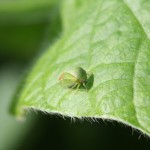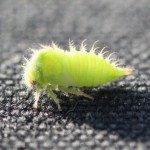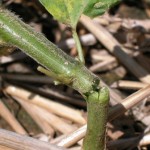Threecornered alfalfa hoppers (TCAH) are a common insect, especially in late planted soybean. Recent data from Mississippi State University strongly suggests that economic damage is only likely to occur in small soybeans, typically those less than 8-inches tall. Tennessee is on the northern edge of where TCAH commonly occur, and populations are sometimes knocked back by cold winters.
Adults and nymphs will feed on the stems of seedling plants with their beak, making a circular girdle around the stem that eventually swells and makes a weak spot. This is usually caused by adults and damage is often worse on field edges where adults are migrating into fields. Girdled plants sometimes break over, and this often happens much later in the season when plants are carrying a pod load. I often get calls of lodging after a wind storm, but this is the result of feeding that occurred many weeks before.
Here are a few points to consider when managing TCAH in soybean.
- Lodging is more likely to occur where plant populations are low. The beans get bushier and more top heavy, and they don’t have neighbors to help support their own weight.
- Insecticides seed treatments help but are not foolproof. Injury often still occurs on field edges. Insecticide seed treatments may not adequate in small fields because adults migrate into fields and cause the injury before succumbing to the insecticide.
- Foliar insecticides such as Orthene/Acephate and the pyrethroids generally provide good control, but applications need to be made before significant girdling has already occurred.
Scouting for threecornered alfalfa hoppers is tricky. One suggestion is to bend seedling soybeans over with a yardstick and sweep-net handle and see how may stems ‘pop over’. Treatment can be considered if 10% or more of the plants are girdled. The “book” says treat when 10% or more of seedling plants are infested, but it is difficult to get an accurate count. I suggest walking fields and looking for these hopping little green bugs. Gently sweeping even very small beans can at least give you some idea if they are common or not. It you are catching 20+ on plants that are not even at V2-V3, that is probably too many, but catching or seeing just a few is no cause for alarm.




